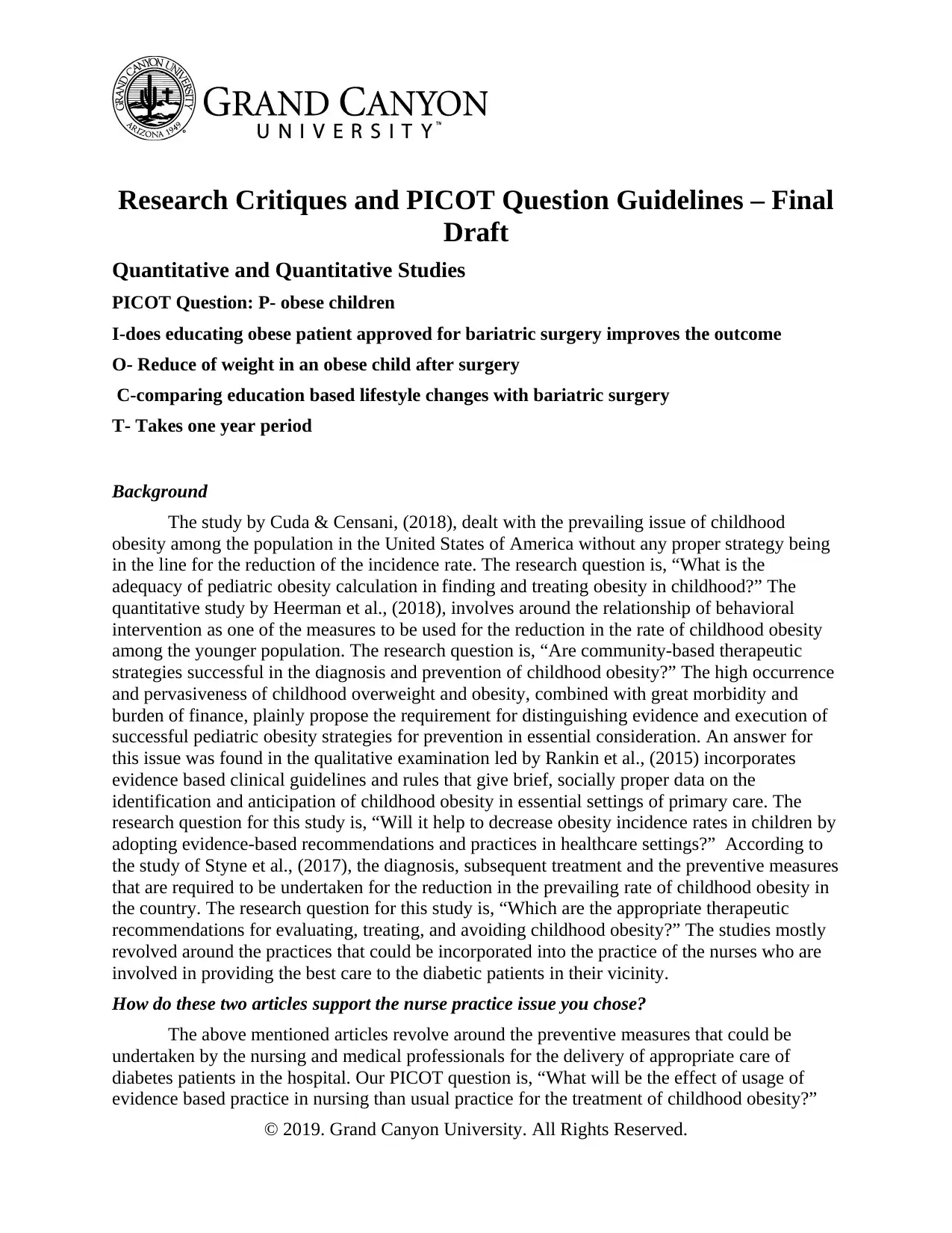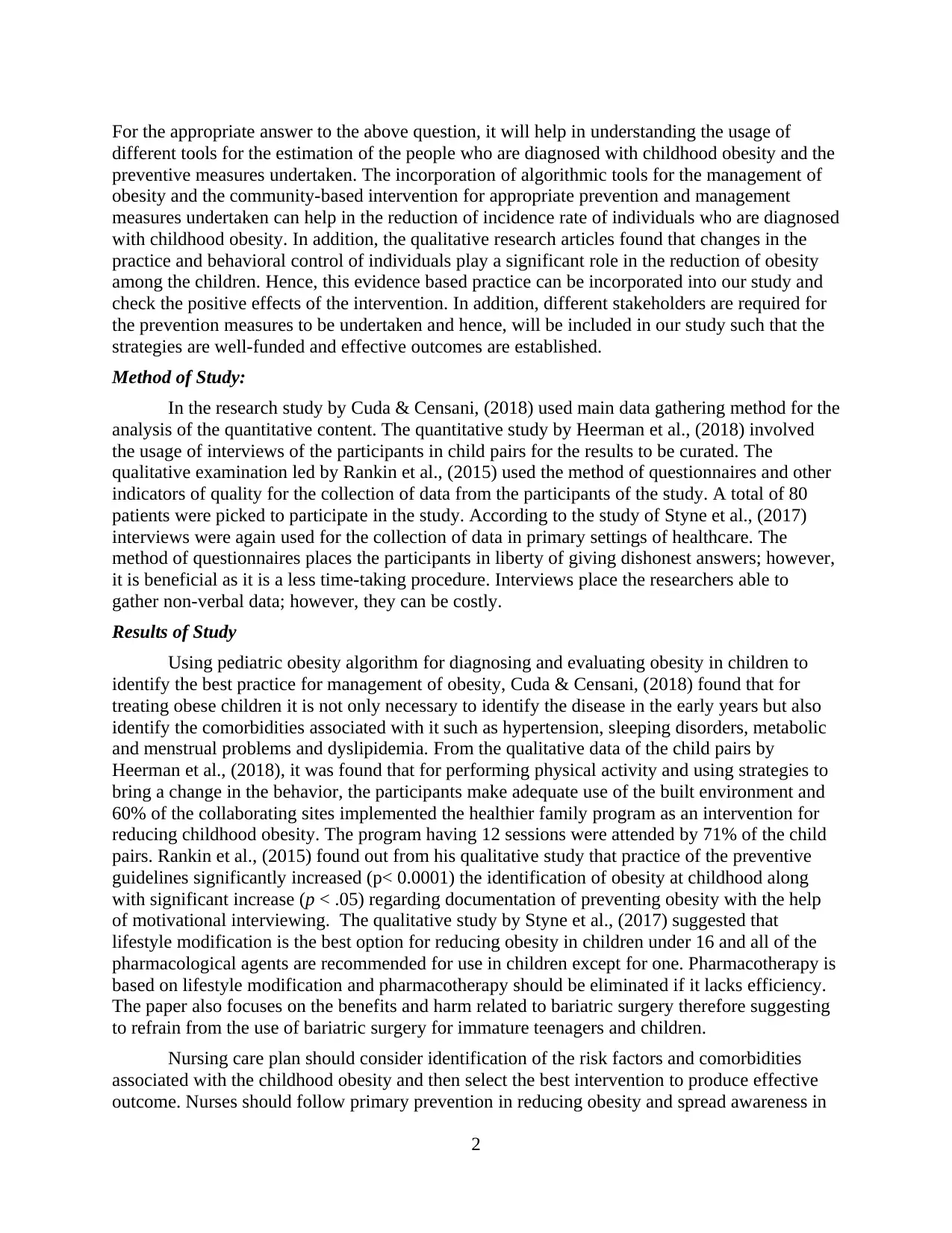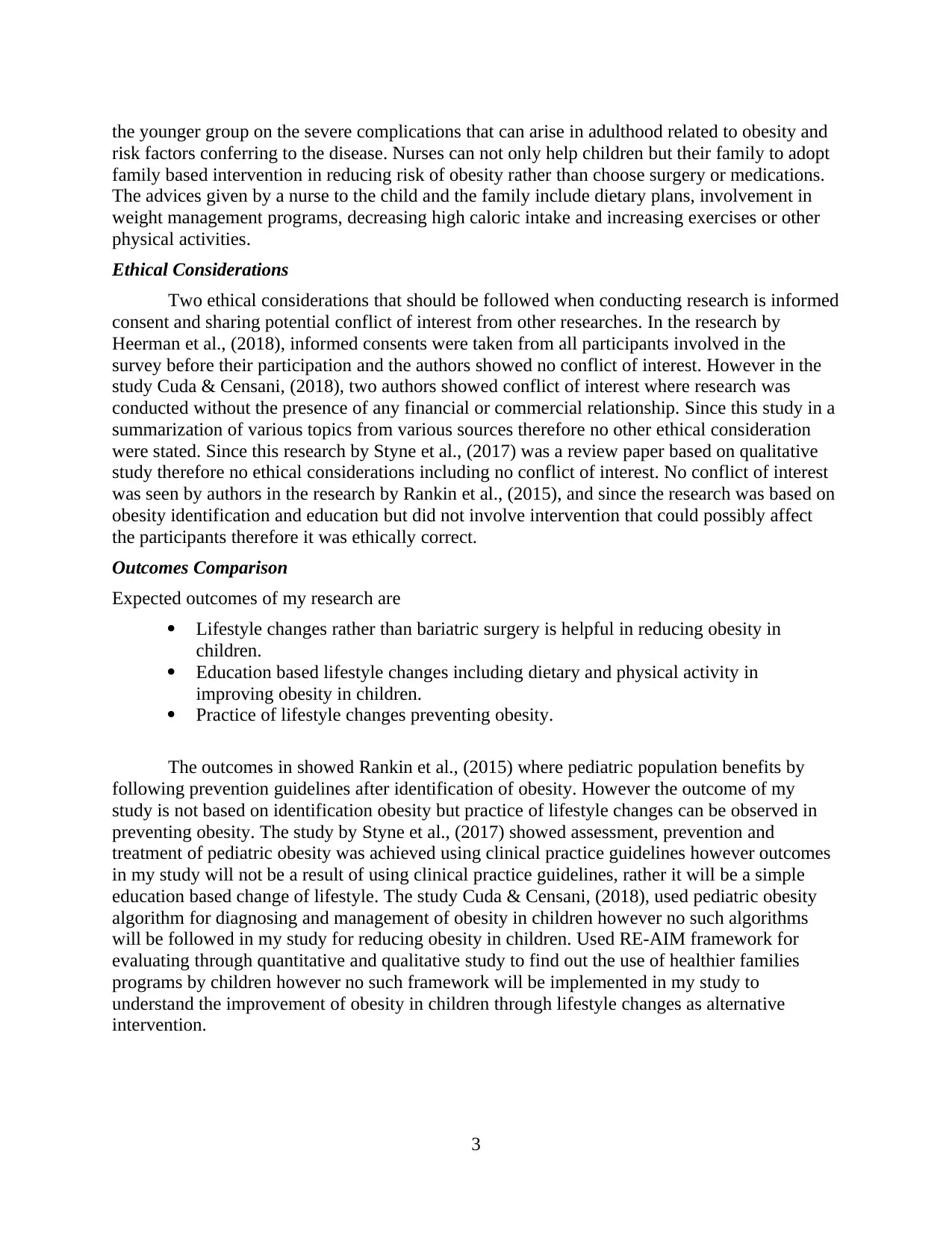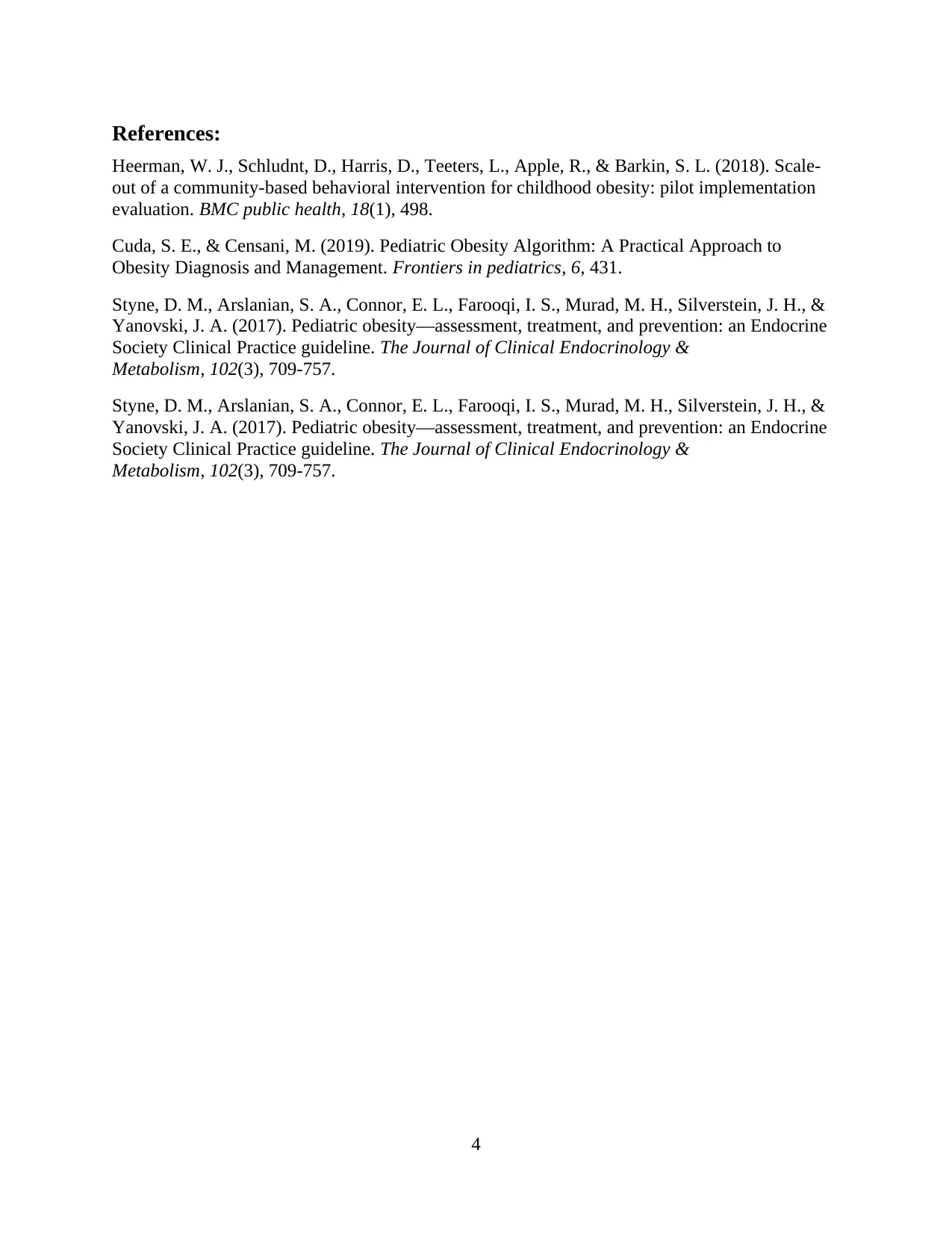Research Critiques and PICOT Question Guidelines – Final Draft Case Study 2022
VerifiedAdded on 2022/08/28
|4
|1894
|119
AI Summary
Contribute Materials
Your contribution can guide someone’s learning journey. Share your
documents today.

Research Critiques and PICOT Question Guidelines – Final
Draft
Quantitative and Quantitative Studies
PICOT Question: P- obese children
I-does educating obese patient approved for bariatric surgery improves the outcome
O- Reduce of weight in an obese child after surgery
C-comparing education based lifestyle changes with bariatric surgery
T- Takes one year period
Background
The study by Cuda & Censani, (2018), dealt with the prevailing issue of childhood
obesity among the population in the United States of America without any proper strategy being
in the line for the reduction of the incidence rate. The research question is, “What is the
adequacy of pediatric obesity calculation in finding and treating obesity in childhood?” The
quantitative study by Heerman et al., (2018), involves around the relationship of behavioral
intervention as one of the measures to be used for the reduction in the rate of childhood obesity
among the younger population. The research question is, “Are community-based therapeutic
strategies successful in the diagnosis and prevention of childhood obesity?” The high occurrence
and pervasiveness of childhood overweight and obesity, combined with great morbidity and
burden of finance, plainly propose the requirement for distinguishing evidence and execution of
successful pediatric obesity strategies for prevention in essential consideration. An answer for
this issue was found in the qualitative examination led by Rankin et al., (2015) incorporates
evidence based clinical guidelines and rules that give brief, socially proper data on the
identification and anticipation of childhood obesity in essential settings of primary care. The
research question for this study is, “Will it help to decrease obesity incidence rates in children by
adopting evidence-based recommendations and practices in healthcare settings?” According to
the study of Styne et al., (2017), the diagnosis, subsequent treatment and the preventive measures
that are required to be undertaken for the reduction in the prevailing rate of childhood obesity in
the country. The research question for this study is, “Which are the appropriate therapeutic
recommendations for evaluating, treating, and avoiding childhood obesity?” The studies mostly
revolved around the practices that could be incorporated into the practice of the nurses who are
involved in providing the best care to the diabetic patients in their vicinity.
How do these two articles support the nurse practice issue you chose?
The above mentioned articles revolve around the preventive measures that could be
undertaken by the nursing and medical professionals for the delivery of appropriate care of
diabetes patients in the hospital. Our PICOT question is, “What will be the effect of usage of
evidence based practice in nursing than usual practice for the treatment of childhood obesity?”
© 2019. Grand Canyon University. All Rights Reserved.
Draft
Quantitative and Quantitative Studies
PICOT Question: P- obese children
I-does educating obese patient approved for bariatric surgery improves the outcome
O- Reduce of weight in an obese child after surgery
C-comparing education based lifestyle changes with bariatric surgery
T- Takes one year period
Background
The study by Cuda & Censani, (2018), dealt with the prevailing issue of childhood
obesity among the population in the United States of America without any proper strategy being
in the line for the reduction of the incidence rate. The research question is, “What is the
adequacy of pediatric obesity calculation in finding and treating obesity in childhood?” The
quantitative study by Heerman et al., (2018), involves around the relationship of behavioral
intervention as one of the measures to be used for the reduction in the rate of childhood obesity
among the younger population. The research question is, “Are community-based therapeutic
strategies successful in the diagnosis and prevention of childhood obesity?” The high occurrence
and pervasiveness of childhood overweight and obesity, combined with great morbidity and
burden of finance, plainly propose the requirement for distinguishing evidence and execution of
successful pediatric obesity strategies for prevention in essential consideration. An answer for
this issue was found in the qualitative examination led by Rankin et al., (2015) incorporates
evidence based clinical guidelines and rules that give brief, socially proper data on the
identification and anticipation of childhood obesity in essential settings of primary care. The
research question for this study is, “Will it help to decrease obesity incidence rates in children by
adopting evidence-based recommendations and practices in healthcare settings?” According to
the study of Styne et al., (2017), the diagnosis, subsequent treatment and the preventive measures
that are required to be undertaken for the reduction in the prevailing rate of childhood obesity in
the country. The research question for this study is, “Which are the appropriate therapeutic
recommendations for evaluating, treating, and avoiding childhood obesity?” The studies mostly
revolved around the practices that could be incorporated into the practice of the nurses who are
involved in providing the best care to the diabetic patients in their vicinity.
How do these two articles support the nurse practice issue you chose?
The above mentioned articles revolve around the preventive measures that could be
undertaken by the nursing and medical professionals for the delivery of appropriate care of
diabetes patients in the hospital. Our PICOT question is, “What will be the effect of usage of
evidence based practice in nursing than usual practice for the treatment of childhood obesity?”
© 2019. Grand Canyon University. All Rights Reserved.
Secure Best Marks with AI Grader
Need help grading? Try our AI Grader for instant feedback on your assignments.

For the appropriate answer to the above question, it will help in understanding the usage of
different tools for the estimation of the people who are diagnosed with childhood obesity and the
preventive measures undertaken. The incorporation of algorithmic tools for the management of
obesity and the community-based intervention for appropriate prevention and management
measures undertaken can help in the reduction of incidence rate of individuals who are diagnosed
with childhood obesity. In addition, the qualitative research articles found that changes in the
practice and behavioral control of individuals play a significant role in the reduction of obesity
among the children. Hence, this evidence based practice can be incorporated into our study and
check the positive effects of the intervention. In addition, different stakeholders are required for
the prevention measures to be undertaken and hence, will be included in our study such that the
strategies are well-funded and effective outcomes are established.
Method of Study:
In the research study by Cuda & Censani, (2018) used main data gathering method for the
analysis of the quantitative content. The quantitative study by Heerman et al., (2018) involved
the usage of interviews of the participants in child pairs for the results to be curated. The
qualitative examination led by Rankin et al., (2015) used the method of questionnaires and other
indicators of quality for the collection of data from the participants of the study. A total of 80
patients were picked to participate in the study. According to the study of Styne et al., (2017)
interviews were again used for the collection of data in primary settings of healthcare. The
method of questionnaires places the participants in liberty of giving dishonest answers; however,
it is beneficial as it is a less time-taking procedure. Interviews place the researchers able to
gather non-verbal data; however, they can be costly.
Results of Study
Using pediatric obesity algorithm for diagnosing and evaluating obesity in children to
identify the best practice for management of obesity, Cuda & Censani, (2018) found that for
treating obese children it is not only necessary to identify the disease in the early years but also
identify the comorbidities associated with it such as hypertension, sleeping disorders, metabolic
and menstrual problems and dyslipidemia. From the qualitative data of the child pairs by
Heerman et al., (2018), it was found that for performing physical activity and using strategies to
bring a change in the behavior, the participants make adequate use of the built environment and
60% of the collaborating sites implemented the healthier family program as an intervention for
reducing childhood obesity. The program having 12 sessions were attended by 71% of the child
pairs. Rankin et al., (2015) found out from his qualitative study that practice of the preventive
guidelines significantly increased (p< 0.0001) the identification of obesity at childhood along
with significant increase (p < .05) regarding documentation of preventing obesity with the help
of motivational interviewing. The qualitative study by Styne et al., (2017) suggested that
lifestyle modification is the best option for reducing obesity in children under 16 and all of the
pharmacological agents are recommended for use in children except for one. Pharmacotherapy is
based on lifestyle modification and pharmacotherapy should be eliminated if it lacks efficiency.
The paper also focuses on the benefits and harm related to bariatric surgery therefore suggesting
to refrain from the use of bariatric surgery for immature teenagers and children.
Nursing care plan should consider identification of the risk factors and comorbidities
associated with the childhood obesity and then select the best intervention to produce effective
outcome. Nurses should follow primary prevention in reducing obesity and spread awareness in
2
different tools for the estimation of the people who are diagnosed with childhood obesity and the
preventive measures undertaken. The incorporation of algorithmic tools for the management of
obesity and the community-based intervention for appropriate prevention and management
measures undertaken can help in the reduction of incidence rate of individuals who are diagnosed
with childhood obesity. In addition, the qualitative research articles found that changes in the
practice and behavioral control of individuals play a significant role in the reduction of obesity
among the children. Hence, this evidence based practice can be incorporated into our study and
check the positive effects of the intervention. In addition, different stakeholders are required for
the prevention measures to be undertaken and hence, will be included in our study such that the
strategies are well-funded and effective outcomes are established.
Method of Study:
In the research study by Cuda & Censani, (2018) used main data gathering method for the
analysis of the quantitative content. The quantitative study by Heerman et al., (2018) involved
the usage of interviews of the participants in child pairs for the results to be curated. The
qualitative examination led by Rankin et al., (2015) used the method of questionnaires and other
indicators of quality for the collection of data from the participants of the study. A total of 80
patients were picked to participate in the study. According to the study of Styne et al., (2017)
interviews were again used for the collection of data in primary settings of healthcare. The
method of questionnaires places the participants in liberty of giving dishonest answers; however,
it is beneficial as it is a less time-taking procedure. Interviews place the researchers able to
gather non-verbal data; however, they can be costly.
Results of Study
Using pediatric obesity algorithm for diagnosing and evaluating obesity in children to
identify the best practice for management of obesity, Cuda & Censani, (2018) found that for
treating obese children it is not only necessary to identify the disease in the early years but also
identify the comorbidities associated with it such as hypertension, sleeping disorders, metabolic
and menstrual problems and dyslipidemia. From the qualitative data of the child pairs by
Heerman et al., (2018), it was found that for performing physical activity and using strategies to
bring a change in the behavior, the participants make adequate use of the built environment and
60% of the collaborating sites implemented the healthier family program as an intervention for
reducing childhood obesity. The program having 12 sessions were attended by 71% of the child
pairs. Rankin et al., (2015) found out from his qualitative study that practice of the preventive
guidelines significantly increased (p< 0.0001) the identification of obesity at childhood along
with significant increase (p < .05) regarding documentation of preventing obesity with the help
of motivational interviewing. The qualitative study by Styne et al., (2017) suggested that
lifestyle modification is the best option for reducing obesity in children under 16 and all of the
pharmacological agents are recommended for use in children except for one. Pharmacotherapy is
based on lifestyle modification and pharmacotherapy should be eliminated if it lacks efficiency.
The paper also focuses on the benefits and harm related to bariatric surgery therefore suggesting
to refrain from the use of bariatric surgery for immature teenagers and children.
Nursing care plan should consider identification of the risk factors and comorbidities
associated with the childhood obesity and then select the best intervention to produce effective
outcome. Nurses should follow primary prevention in reducing obesity and spread awareness in
2

the younger group on the severe complications that can arise in adulthood related to obesity and
risk factors conferring to the disease. Nurses can not only help children but their family to adopt
family based intervention in reducing risk of obesity rather than choose surgery or medications.
The advices given by a nurse to the child and the family include dietary plans, involvement in
weight management programs, decreasing high caloric intake and increasing exercises or other
physical activities.
Ethical Considerations
Two ethical considerations that should be followed when conducting research is informed
consent and sharing potential conflict of interest from other researches. In the research by
Heerman et al., (2018), informed consents were taken from all participants involved in the
survey before their participation and the authors showed no conflict of interest. However in the
study Cuda & Censani, (2018), two authors showed conflict of interest where research was
conducted without the presence of any financial or commercial relationship. Since this study in a
summarization of various topics from various sources therefore no other ethical consideration
were stated. Since this research by Styne et al., (2017) was a review paper based on qualitative
study therefore no ethical considerations including no conflict of interest. No conflict of interest
was seen by authors in the research by Rankin et al., (2015), and since the research was based on
obesity identification and education but did not involve intervention that could possibly affect
the participants therefore it was ethically correct.
Outcomes Comparison
Expected outcomes of my research are
Lifestyle changes rather than bariatric surgery is helpful in reducing obesity in
children.
Education based lifestyle changes including dietary and physical activity in
improving obesity in children.
Practice of lifestyle changes preventing obesity.
The outcomes in showed Rankin et al., (2015) where pediatric population benefits by
following prevention guidelines after identification of obesity. However the outcome of my
study is not based on identification obesity but practice of lifestyle changes can be observed in
preventing obesity. The study by Styne et al., (2017) showed assessment, prevention and
treatment of pediatric obesity was achieved using clinical practice guidelines however outcomes
in my study will not be a result of using clinical practice guidelines, rather it will be a simple
education based change of lifestyle. The study Cuda & Censani, (2018), used pediatric obesity
algorithm for diagnosing and management of obesity in children however no such algorithms
will be followed in my study for reducing obesity in children. Used RE-AIM framework for
evaluating through quantitative and qualitative study to find out the use of healthier families
programs by children however no such framework will be implemented in my study to
understand the improvement of obesity in children through lifestyle changes as alternative
intervention.
3
risk factors conferring to the disease. Nurses can not only help children but their family to adopt
family based intervention in reducing risk of obesity rather than choose surgery or medications.
The advices given by a nurse to the child and the family include dietary plans, involvement in
weight management programs, decreasing high caloric intake and increasing exercises or other
physical activities.
Ethical Considerations
Two ethical considerations that should be followed when conducting research is informed
consent and sharing potential conflict of interest from other researches. In the research by
Heerman et al., (2018), informed consents were taken from all participants involved in the
survey before their participation and the authors showed no conflict of interest. However in the
study Cuda & Censani, (2018), two authors showed conflict of interest where research was
conducted without the presence of any financial or commercial relationship. Since this study in a
summarization of various topics from various sources therefore no other ethical consideration
were stated. Since this research by Styne et al., (2017) was a review paper based on qualitative
study therefore no ethical considerations including no conflict of interest. No conflict of interest
was seen by authors in the research by Rankin et al., (2015), and since the research was based on
obesity identification and education but did not involve intervention that could possibly affect
the participants therefore it was ethically correct.
Outcomes Comparison
Expected outcomes of my research are
Lifestyle changes rather than bariatric surgery is helpful in reducing obesity in
children.
Education based lifestyle changes including dietary and physical activity in
improving obesity in children.
Practice of lifestyle changes preventing obesity.
The outcomes in showed Rankin et al., (2015) where pediatric population benefits by
following prevention guidelines after identification of obesity. However the outcome of my
study is not based on identification obesity but practice of lifestyle changes can be observed in
preventing obesity. The study by Styne et al., (2017) showed assessment, prevention and
treatment of pediatric obesity was achieved using clinical practice guidelines however outcomes
in my study will not be a result of using clinical practice guidelines, rather it will be a simple
education based change of lifestyle. The study Cuda & Censani, (2018), used pediatric obesity
algorithm for diagnosing and management of obesity in children however no such algorithms
will be followed in my study for reducing obesity in children. Used RE-AIM framework for
evaluating through quantitative and qualitative study to find out the use of healthier families
programs by children however no such framework will be implemented in my study to
understand the improvement of obesity in children through lifestyle changes as alternative
intervention.
3

References:
Heerman, W. J., Schludnt, D., Harris, D., Teeters, L., Apple, R., & Barkin, S. L. (2018). Scale-
out of a community-based behavioral intervention for childhood obesity: pilot implementation
evaluation. BMC public health, 18(1), 498.
Cuda, S. E., & Censani, M. (2019). Pediatric Obesity Algorithm: A Practical Approach to
Obesity Diagnosis and Management. Frontiers in pediatrics, 6, 431.
Styne, D. M., Arslanian, S. A., Connor, E. L., Farooqi, I. S., Murad, M. H., Silverstein, J. H., &
Yanovski, J. A. (2017). Pediatric obesity—assessment, treatment, and prevention: an Endocrine
Society Clinical Practice guideline. The Journal of Clinical Endocrinology &
Metabolism, 102(3), 709-757.
Styne, D. M., Arslanian, S. A., Connor, E. L., Farooqi, I. S., Murad, M. H., Silverstein, J. H., &
Yanovski, J. A. (2017). Pediatric obesity—assessment, treatment, and prevention: an Endocrine
Society Clinical Practice guideline. The Journal of Clinical Endocrinology &
Metabolism, 102(3), 709-757.
4
Heerman, W. J., Schludnt, D., Harris, D., Teeters, L., Apple, R., & Barkin, S. L. (2018). Scale-
out of a community-based behavioral intervention for childhood obesity: pilot implementation
evaluation. BMC public health, 18(1), 498.
Cuda, S. E., & Censani, M. (2019). Pediatric Obesity Algorithm: A Practical Approach to
Obesity Diagnosis and Management. Frontiers in pediatrics, 6, 431.
Styne, D. M., Arslanian, S. A., Connor, E. L., Farooqi, I. S., Murad, M. H., Silverstein, J. H., &
Yanovski, J. A. (2017). Pediatric obesity—assessment, treatment, and prevention: an Endocrine
Society Clinical Practice guideline. The Journal of Clinical Endocrinology &
Metabolism, 102(3), 709-757.
Styne, D. M., Arslanian, S. A., Connor, E. L., Farooqi, I. S., Murad, M. H., Silverstein, J. H., &
Yanovski, J. A. (2017). Pediatric obesity—assessment, treatment, and prevention: an Endocrine
Society Clinical Practice guideline. The Journal of Clinical Endocrinology &
Metabolism, 102(3), 709-757.
4
1 out of 4
Related Documents
Your All-in-One AI-Powered Toolkit for Academic Success.
+13062052269
info@desklib.com
Available 24*7 on WhatsApp / Email
![[object Object]](/_next/static/media/star-bottom.7253800d.svg)
Unlock your academic potential
© 2024 | Zucol Services PVT LTD | All rights reserved.


